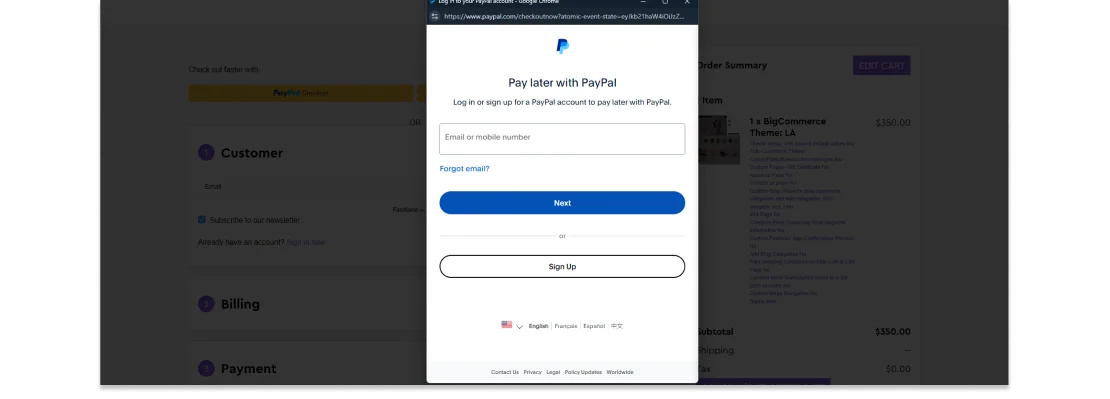
In today’s competitive online market, having an eCommerce website that stands out is essential for success. But it’s not just about having a visually appealing design; your website needs to offer functionality, usability, and a seamless shopping experience. Whether you’re launching a new online store or looking to redesign your existing one, incorporating the right features can make all the difference. In this blog, we’ll cover the key eCommerce website features that you should implement to ensure a well-designed, high-converting, and user-friendly online store.
Why eCommerce Website Features Matter
The features you choose to integrate into your website can directly impact user experience, conversion rates, and even your SEO rankings. An optimized website not only helps attract potential customers but also encourages them to stay, explore, and complete a purchase. This is where effective website design and web development come into play. By focusing on the most essential features, you create an online store that’s intuitive, engaging, and ready to convert visitors into loyal customers.
User-Friendly Navigation
Having an intuitive navigation structure is fundamental to the success of any eCommerce website. When customers visit your site, they should be able to browse products and categories without any difficulty. This means organizing your products into clear categories and subcategories and ensuring that the menu is accessible and easy to understand. A search bar should be prominently placed on the website, allowing customers to find what they’re looking for quickly and efficiently, especially on websites with a large inventory.
 Dick Pond Athletics User-Friendly Navigation
Dick Pond Athletics User-Friendly Navigation
Incorporating breadcrumbs can further enhance the user experience by providing a trail of the user’s journey through your website, making it easier for them to backtrack to previous pages. Not only does this make it easier for customers to navigate your site, but it also aids in SEO by helping search engines understand the structure of your website better.
Mobile-Responsive Design
With an increasing number of shoppers making purchases via their smartphones, a mobile-responsive design is no longer optional but mandatory. A website that adjusts seamlessly to different screen sizes ensures that your potential customers have a consistent shopping experience, regardless of the device they’re using. It’s essential to ensure that your product images, text, buttons, and checkout process are optimized for mobile devices, making it easy for visitors to browse and buy without frustration.
 RaidResearch’s Mobile-Responsive Design
RaidResearch’s Mobile-Responsive Design
Moreover, Google has prioritized mobile-first indexing, meaning that mobile-friendly websites rank better on search engine results pages (SERPs). This makes having a mobile-responsive design not only important for user experience but also essential for your SEO strategy.
High-Quality Product Images and Videos
Visuals are crucial in eCommerce as they help customers get a clear understanding of what they’re buying. Providing high-quality images and videos for your products can significantly enhance the shopping experience. Multiple images taken from different angles, including zoomed-in shots, allow customers to examine the details of a product, thereby increasing their confidence in making a purchase.
Videos can be particularly effective in showcasing how a product works or looks in real life, giving customers a more comprehensive understanding of the product. This helps reduce the chances of returns and ensures that customers are satisfied with their purchase. Including this level of detail in your website design will create a more engaging shopping experience and help convert casual visitors into buyers.
Secure Payment Gateway and Multiple Payment Options
Security is a primary concern for online shoppers, especially when they’re ready to make a payment. Integrating a secure payment gateway ensures that your customers’ financial information is protected. Having SSL encryption not only safeguards transactions but also builds trust with your customers, reassuring them that their data is secure.
Offering multiple payment options is another essential feature for an eCommerce website. By providing a variety of payment methods—such as credit/debit cards, PayPal, Apple Pay, and even “Buy Now, Pay Later” services like Klarna—you cater to different customer preferences, making it more convenient for them to complete their purchase. This can significantly reduce cart abandonment rates and boost eCommerce sales.
 PayPal’s Buy Now Pay Later Option
PayPal’s Buy Now Pay Later Option
Fast Loading Speed
Website speed plays a crucial role in customer experience and SEO rankings. Research shows that visitors are likely to abandon a site if it takes more than a few seconds to load. This means that ensuring your eCommerce website is optimized for speed is essential for keeping potential customers engaged. To achieve fast loading times, consider compressing images, using a reliable hosting provider, and minimizing heavy scripts or plugins that may slow down your site.
A faster website not only improves the overall user experience but also positively impacts your SEO rankings, as Google favors websites with quick loading times. This makes optimizing for speed a key component of both your web development and digital marketing strategies.
Detailed Product Descriptions
A well-written product description serves as a sales pitch, helping customers understand the benefits and features of a product. Instead of simply listing specifications, focus on crafting compelling descriptions that highlight the unique selling points, advantages, and practical uses of the product. Incorporating keywords into your product descriptions also helps improve your website’s SEO, making it easier for potential customers to find your products through search engines.

It’s important to remember that a detailed product description not only informs the customer but also helps to reduce the chances of returns. By providing all the necessary information upfront, you set clear expectations, resulting in a smoother purchasing process and higher customer satisfaction.
Customer Reviews and Ratings
Customer reviews and ratings act as social proof and play a significant role in influencing potential buyers. Displaying reviews on your product pages ?builds trust and credibility, showing that others have had positive experiences with your products. This helps reassure new customers and encourages them to complete their purchase.
Encourage your customers to leave reviews by sending follow-up emails after their purchase, offering incentives, or providing easy-to-use review submission forms. This not only adds valuable content to your website but also contributes to your SEO by adding fresh, user-generated content.
Easy Checkout Process
An easy and straightforward checkout process is crucial for reducing cart abandonment rates. Many customers abandon their carts due to complicated or lengthy checkout procedures. To prevent this, streamline your checkout process by minimizing the number of steps required to complete a purchase and offering a guest checkout option. This ensures that even first-time customers can quickly and efficiently complete their purchase without the hassle of creating an account.
Additionally, include a progress bar during checkout to show customers how far they are in the process. This transparency helps reduce frustration and encourages customers to complete their purchase, leading to higher conversion rates.
SEO-Friendly Structure
SEO plays a fundamental role in driving organic traffic to your eCommerce website. Optimizing your website for search engines involves more than just using keywords; it’s about ensuring that your website has an SEO-friendly structure. This includes optimizing meta titles, descriptions, headers, URLs, and incorporating alt text for images. Creating a clear hierarchy with proper internal linking also helps search engines understand your website’s structure, improving your chances of ranking higher in search results.
An SEO-optimized website is more likely to attract organic traffic, which leads to increased visibility and sales. Therefore, integrating SEO into your web development process from the start is essential for long-term success.
Integration with Social Media
Social media integration can significantly boost your eCommerce website’s visibility and drive traffic. Adding social sharing buttons to your product pages, blog posts, and other sections of your website makes it easy for customers to share your content with their followers. Additionally, integrating a live Instagram feed on your website can showcase real-life customer experiences with your products, building authenticity and encouraging others to explore your offerings.
By leveraging social media, you create more opportunities for engagement, brand exposure, and website traffic, making it an essential part of your digital marketing strategy.
Personalized User Experience
Incorporating personalization into your eCommerce website design can significantly enhance the customer experience. Personalization involves tailoring the shopping experience to individual customers based on their preferences, browsing behavior, and purchase history. This can be achieved through personalized product recommendations, targeted email marketing, or customized content.
A personalized user experience makes customers feel valued, which can increase engagement, encourage repeat purchases, and ultimately improve conversion rates. Implementing personalization tools into your website is a great way to create a more engaging and relevant shopping experience for your customers.
Conclusion
Incorporating the right eCommerce website features is crucial for creating a seamless, enjoyable, and successful online shopping experience. From user-friendly navigation and mobile responsiveness to secure payment gateways and SEO-friendly structures, each feature plays a vital role in your website’s overall performance.
If you’re in the process of building or redesigning your eCommerce website, consider these essential features to ensure you’re providing the best possible experience for your customers. A well-designed and functional website not only attracts visitors but also increases customer retention ultimately driving your eCommerce success.

 Eashan Mehta
Eashan Mehta




